Substance, Paris | A Brilliant New Bistro in the 16th Arrondissement, A-
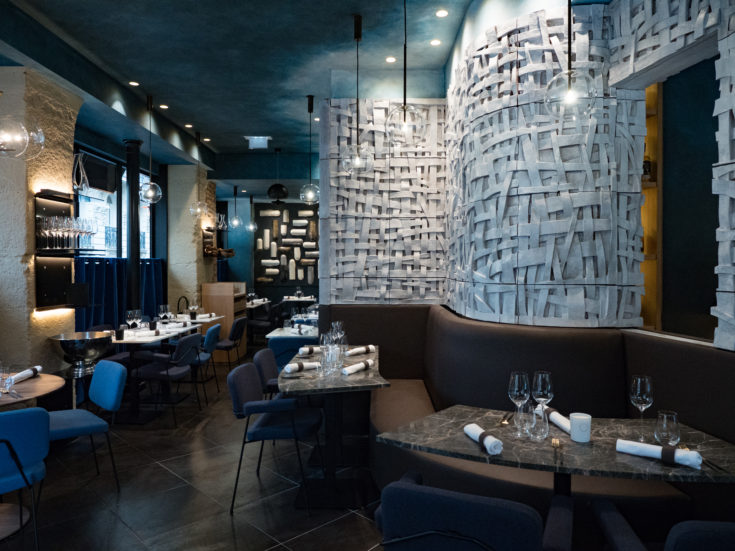
Substance is such a good restaurant that it’s well worth traveling to a quiet corner of the 16th Arrondissement to discover the sinewy talent of young chef Matthias Marc, 25, a native of the Jura in eastern France. Marc signs many of his dishes with a witty wink at this eastern French region of mountains and forests best-known gastronomically for producing Comte cheese and charcuterie like morteau sausage, but his his sensibility is decidedly cosmopolitan on a solid Gallic base. His cooking is also stunningly precise and intriguingly imaginative. I predict that he’s going to become one of the best chefs in his generation, too.
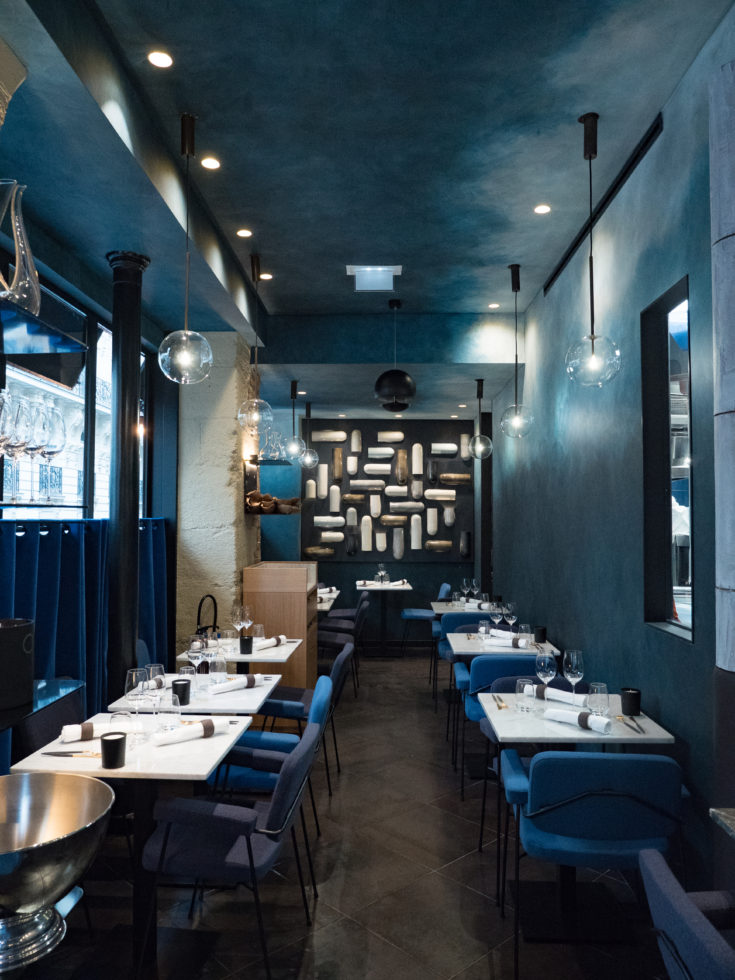
Marc honed his cooking style when he was working at the very popular Racines des Prés just off the rue du Bac in the 7th Arrondissement, but eager to have his own kitchen, he teamed up with Anthony Pedrosa, who ran the dining at this same restaurant, and Stéphane Manigold, a businessman with a passionate interest in gastronomy to create this excellent new table.
Taking a leaf from Racines, they commissioned interior designer Michel Amarettos to create an intimate modern bistro with a low-key contemporary chic conveyed by an open kitchen that overlooks the dining room, bare tables with white and teal fabric covered Sixties style arm chairs and basket-weave ceramic panels on the walls. Not surprisingly, Substance has been hugely popular ever since it opened a few months ago, and it seems that the 16th Arrondissement, a part of Paris that’s not usually on my beat, since most of the city’s best young chefs are to be found in double digit arrondissements of eastern Paris like the 11th and 20th these days, is rousing from a certain culinary turpitude with this opening and that of other excellent restaurants like Comice.
This address is also much appreciated by people staying at hotels in western Paris like the Peninsula, the George V, the Prince de Galles, the Shangri-La and other properties within an easy walk of this address.
Sitting just across from the open kitchen, it was fascinating to watch the ballet of chefs at work in a compact space, and also interact regularly with Anthony Pedrosa, this restaurant’s excellent sommelier, as he regularly visited the restaurant’s wine tower, adjacent to our table. Substance has an exceptionally good wine list, including over 180 different Champagnes. The Champagne selection was drawn up by Anselme Selosse, the cult Champagne producer whose signature wine is called “Substance,” hence the restaurant’s name, and Stéphane Manigold, and it highlights a variety of ‘grower’ Champagnes, or Champagnes from small producers like Laherte Frères, a small producer based on the Montagne de Reims just outside of Reims. This makes Substance one of the best addresses in Paris for Champagne lovers.
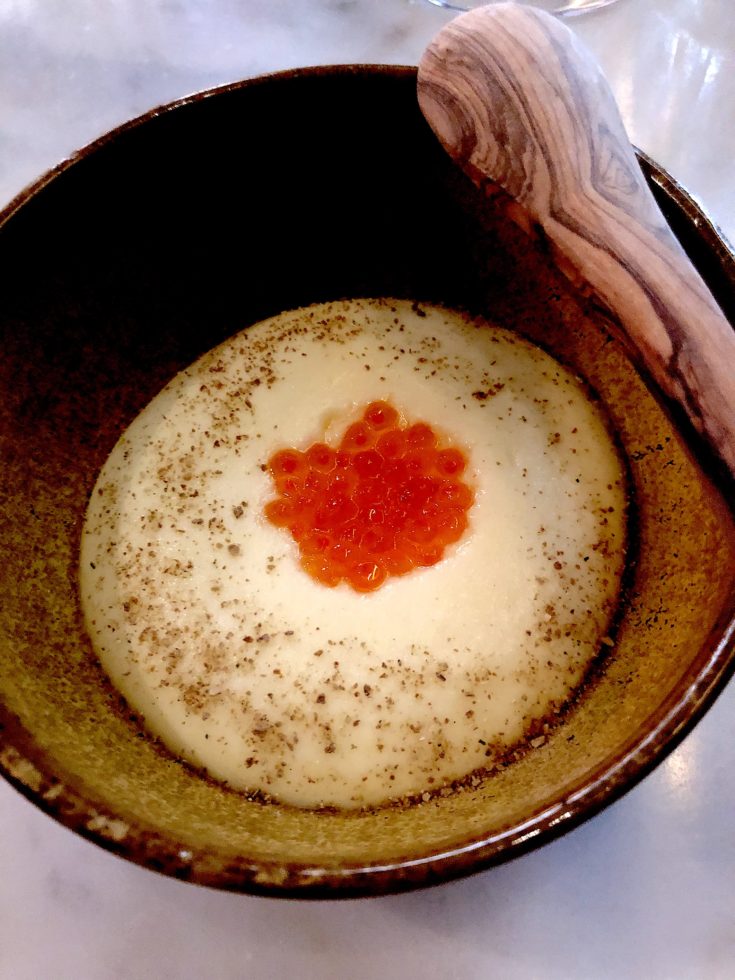
Our meal began with a simple but elegant amuse bouche of smoked cream with salmon eggs and dried pine-needle powder, a garnish that curiously flattered the glossy orange fish pearls with a subtle resinous flavor and also announced chef Marc’s attachment to his native Jura.
The surrounding clientele offered an amusing demographic snap shot of this affluent part of Paris, too. To my left, a table of four forty-something men in jeans and blazers guffawed about their girl friends and a recent weekend in Saint Tropez, several middle-aged couples sat stonily with their heads cocked in different directions as a possible prelude to a divorce, and three well-dressed older ladies with the same meringue-colored hair and expensive pocket books appeared intrigued by the adventure of being in a trendy restaurant. There were several tables of girl friends dining out after work, and here and there, a younger couple that called out the fact that this bourgeois neighborhood has now become a relatively good-value neighborhood on the Monopoly board of Paris real estate.
Still, the aura of entitlement that hovered over most of the tables here brought me back to musing on a subject I’d last visited during an excellent meal at Batard, a “modern European” restaurant in New York City, in February. This is how the clientele of a restaurant can impact on the way you perceive of its cooking and also your experience of being there.
That cold night in New York City, I was dining with a much-loved old friend, and we we were paying our own bill, which was in contrast to the mostly loud, smug expense-account wielding clients in this very pretty dining room. For most of them, it was just another night out on the corporate purse, while for us it was a special occasion, and several times during that meal, I had to actively discipline myself to screen out the officious and reflexively privileged behavior at some of the surrounding tables. You can’t, of course, control who else you’ll be dining with in a public setting, but it certainly can have a very big impact on how much you enjoy your meal, and I also couldn’t help but feel frequently exasperated by the inattention given to some really superb cooking by people who were there not because they wanted to eat well, but because they had the money to pay for it.
This is due to the deep reverence I have for the culinary professions, stemming not only for the hours I’ve spent in kitchens all over the world as a food writer, but also going back to the days when I was variously a prep cook, bus boy and waiter in New England seaside hotels during college summers and also to a stint as a 11pm-5am baker in a New York City kitchen that had me standing warily on the subway platform at West 72nd Street at 5.15am with flour in my hair, an aching back and an adrenaline woke wariness of riding the subway in the dead of night in New York in the 1980s. The short take on all of this? Most people have absolutely no clue how hard a kitchen works with the goal of delivering gastronomic pleasure, because if they did, they’d be much much more grateful.
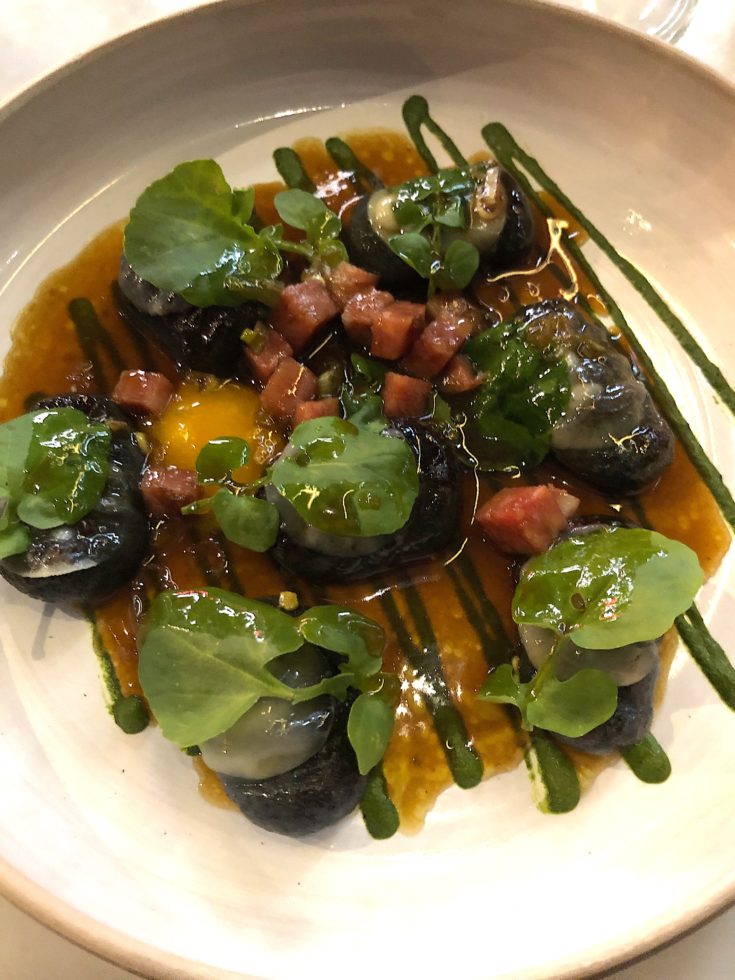
Our starters at Substance were superb. I loved my fluffy squid’s ink gnocchi with a smoked egg-yolk condiment, pickled watercress sauce and a jus de morteau, because it was an earthy and deeply satisfying dish that flashed with culinary wit and invention.
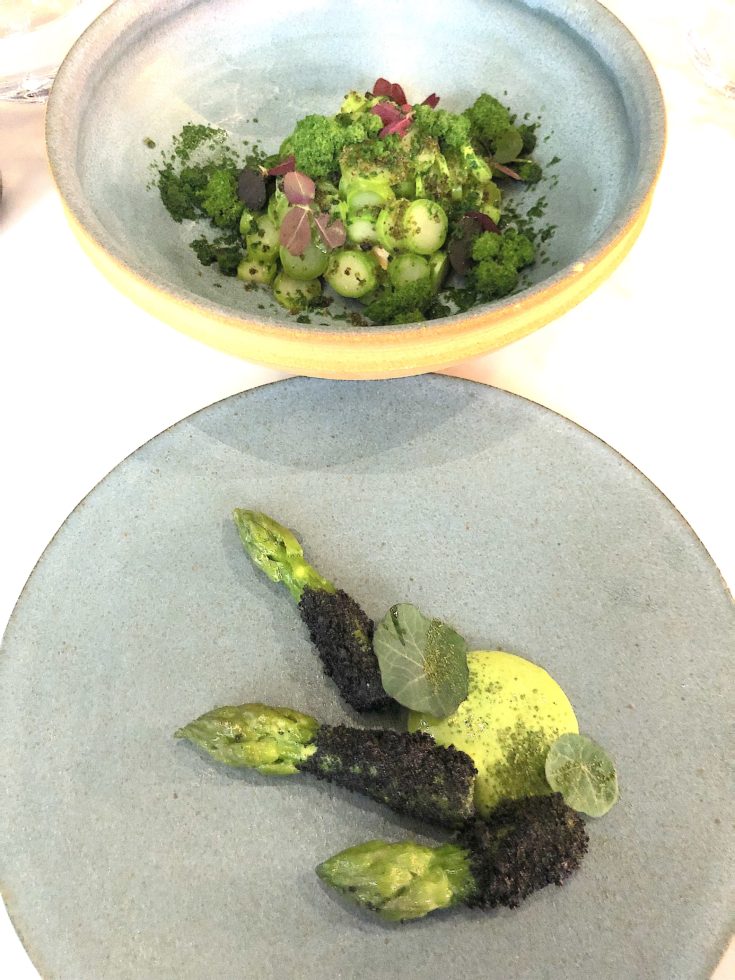
Bruno’s perfectly cooked green asparagus came prepared two different ways–their tips with a tangy ramp cream and their steams chopped and served with trout rillettes with a funky floral hay-infused vinaigrette. This composition was a steely equilibrium of the rustic and the urbane that was a perfect example of Matthias Marc’s cooking, too.
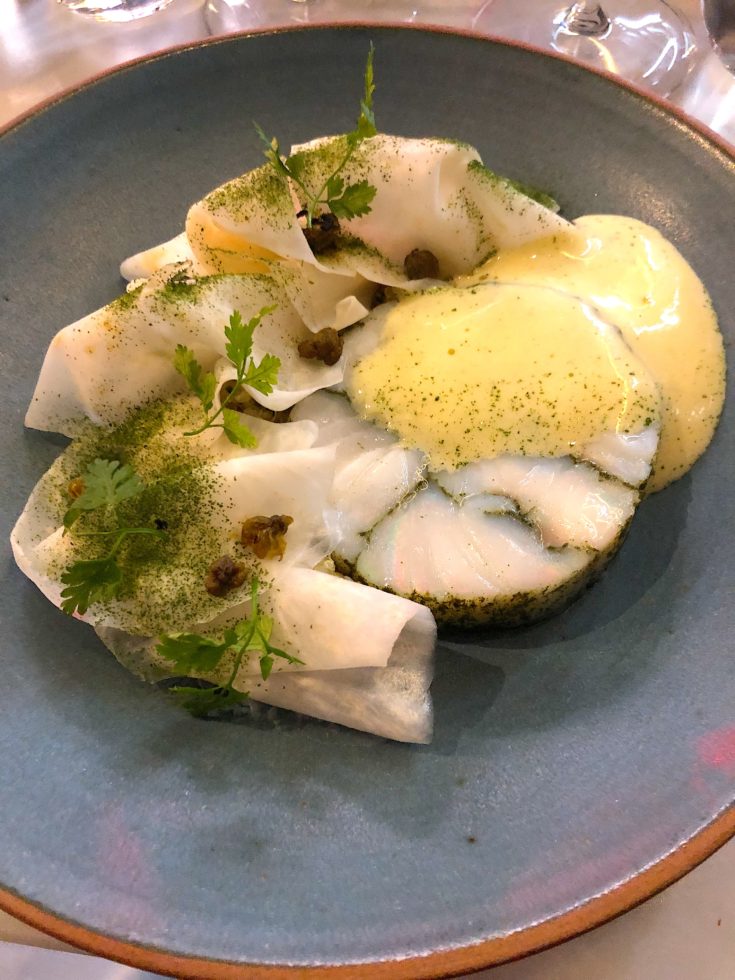
Our main courses were spectacular, too. My rolled John Dory came on a bed of quinoa with fresh celery root pickles, fried capers and a luscious gently cardamom-flavored sabayon. The fish was succulent, and its accompanying condiments added texture and suavely percussive gastronomic punctuation to a brilliantly conceived and executed dish.
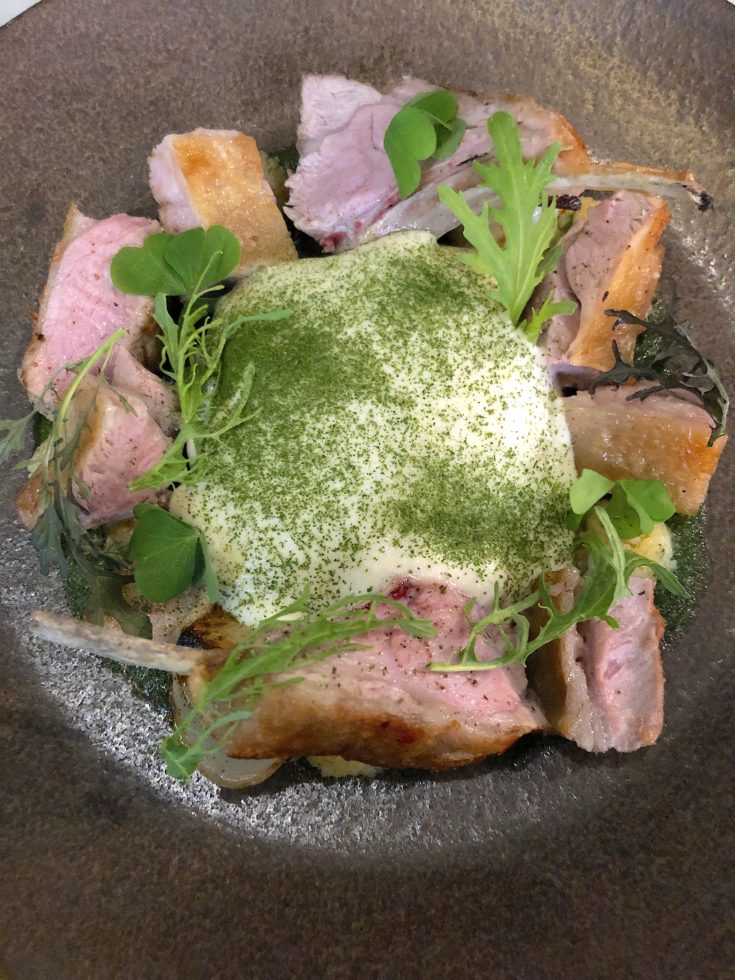
Bruno’s roast baby lamb with Comte cheese foam, seared baby onions and more dried pine needle powder was gorgeous springtime eating, too, and a great example of the discreet but wiry sensuality that is a signature of Matthias Marc’s excellent contemporary French cooking at Substance.
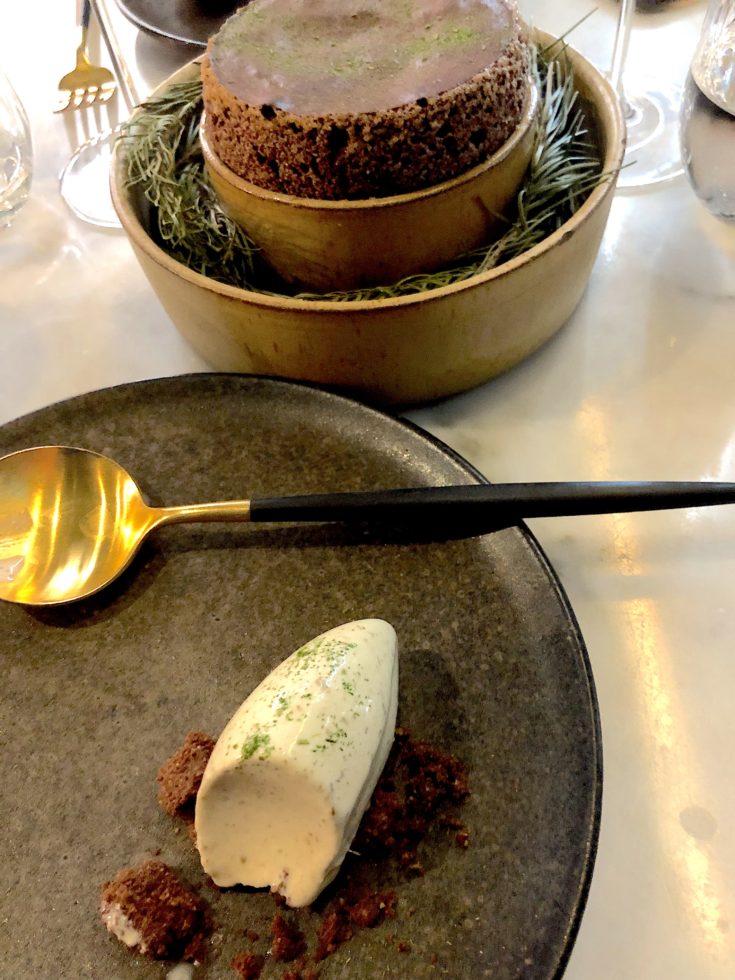
There was no way were going to miss the Sao Tome chocolate souffle with bitter cocoa crumble and pine-flavored ice cream for two for dessert either, and it had a funky fruity tropical fruitiness that lofted us us out of Paris to the tiny island in the bight of Western Africa where the cocoa beans were grown.
Substance is an excellent restaurant, and an excellent venue in which to uncork a really good bottle of Champagne.
18 rue de Chaillot, 16th Arrondissement, Paris, Tel. (33) 01-47-20-08-90. Metro: Alma-Marceau. Open for lunch and dinner from Monday to Friday. Closed Saturday and Sunday. Lunch menus 35 Euros, 36 Euros; carte blanche menu 79 Euros; average a la carte 75 Euros. www.substance.paris




